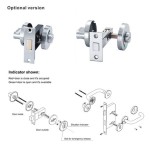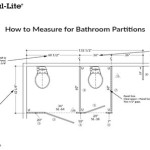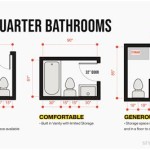Eco-Friendly Bathroom Ideas: Creating a Sustainable Oasis
The bathroom, a space typically associated with personal hygiene and relaxation, often contributes significantly to household water and energy consumption. This consumption, in turn, impacts the environment. Implementing eco-friendly practices in the bathroom can substantially reduce this impact, promoting a more sustainable lifestyle. This article explores several practical and effective eco-friendly bathroom ideas, focusing on water conservation, energy efficiency, and the use of sustainable materials.
Water Conservation Strategies
Water conservation is a cornerstone of any eco-conscious bathroom. Modern bathrooms often feature fixtures that consume excessive amounts of water, leading to unnecessary strain on water resources and increased utility bills. Retrofitting or replacing these fixtures with water-efficient alternatives can drastically reduce water usage without compromising functionality.
One of the most significant areas for water conservation is the toilet. Traditional toilets can use up to 3.5 gallons (approximately 13 liters) of water per flush. High-efficiency toilets (HETs), also known as low-flow toilets, use 1.6 gallons (approximately 6 liters) or less per flush. Dual-flush toilets offer further water savings by allowing users to select a reduced flush volume for liquid waste. Installing an HET or dual-flush toilet is a relatively simple upgrade that can yield substantial long-term water savings.
Showerheads are another critical focus for water conservation efforts. Older showerheads can release water at a rate of 5 gallons (approximately 19 liters) per minute or more. Low-flow showerheads, on the other hand, typically use 2.5 gallons (approximately 9.5 liters) per minute or less. These showerheads use various technologies such as aeration or pressure regulation to maintain a satisfying shower experience while minimizing water consumption. Consider installing an adjustable low-flow showerhead to customize the water flow according to individual preferences.
Faucets also contribute to overall water consumption. Aerating faucets mix air with water, reducing the actual water flow while maintaining adequate pressure. Installing low-flow aerators on existing faucets is an inexpensive and easy way to conserve water. Motion-sensor faucets, which automatically turn off the water when hands are removed, can further reduce water waste, particularly in households with young children or individuals prone to accidentally leaving the water running.
Beyond fixture upgrades, behavioral changes can also significantly impact water consumption. Taking shorter showers, turning off the tap while brushing teeth or shaving, and fixing leaky faucets promptly are simple yet effective strategies for minimizing water waste. Educating household members about the importance of water conservation can encourage a more conscious approach to water usage throughout the home.
Energy Efficiency Enhancements
Energy efficiency is another crucial aspect of creating an eco-friendly bathroom. Bathrooms often rely on electricity for lighting, ventilation, and heating, contributing to a household's overall energy footprint. Implementing energy-efficient technologies and practices can significantly reduce this footprint, lowering energy bills and minimizing environmental impact.
Lighting is a primary area for energy conservation in the bathroom. Traditional incandescent light bulbs are highly inefficient, converting only a small percentage of the electricity they consume into light, with the majority being lost as heat. Switching to energy-efficient lighting options, such as LED (light-emitting diode) bulbs, can dramatically reduce energy consumption. LED bulbs use significantly less energy than incandescent bulbs and have a much longer lifespan, reducing the frequency of replacements. Consider using natural light whenever possible, by maximizing window space or installing a skylight. Natural light not only reduces the need for artificial lighting but also enhances the aesthetic appeal of the bathroom.
Ventilation fans are essential for removing moisture and preventing mold growth in bathrooms. However, older ventilation fans can be energy inefficient and noisy. Consider replacing an old ventilation fan with a newer, energy-efficient model that is designed to operate quietly. Look for fans with the Energy Star label, which indicates that they meet strict energy efficiency standards. Timers can be installed on ventilation fans to ensure they only run for the necessary amount of time, further reducing energy consumption.
Water heating accounts for a significant portion of household energy consumption. Insulating hot water pipes can reduce heat loss as water travels from the water heater to the bathroom, ensuring that hot water is readily available when needed. Consider lowering the temperature setting on the water heater to reduce energy consumption without compromising comfort. Tankless water heaters, which heat water on demand rather than storing it in a tank, can also be a more energy-efficient option, particularly for households with low or intermittent hot water usage.
Sustainable Material Selection
The materials used in bathroom construction and renovation can have a significant impact on the environment. Choosing sustainable and eco-friendly materials can minimize the environmental footprint of the bathroom and promote a healthier indoor environment. Sustainable materials are typically renewable, recycled, or manufactured using environmentally responsible processes.
For flooring, consider options such as bamboo, cork, or recycled glass tiles. Bamboo is a rapidly renewable resource that grows quickly and requires minimal pesticides or fertilizers. Cork is harvested from the bark of cork oak trees without harming the tree, making it a sustainable and renewable option. Recycled glass tiles are made from post-consumer or post-industrial glass waste, diverting materials from landfills and reducing the need for virgin resources. Avoid using materials like vinyl, which is made from petroleum and can release harmful chemicals into the air.
For countertops, consider using recycled glass, bamboo, or reclaimed wood. Recycled glass countertops are made from crushed recycled glass mixed with a binder, creating a durable and aesthetically pleasing surface. Reclaimed wood is salvaged from old buildings or structures, giving it a new life and reducing the demand for newly harvested timber. Bamboo countertops offer a sustainable and stylish alternative to traditional wood countertops.
For cabinetry, opt for cabinets made from sustainably harvested wood, recycled wood, or formaldehyde-free materials. Look for cabinets certified by the Forest Stewardship Council (FSC), which ensures that the wood comes from responsibly managed forests. Formaldehyde is a common chemical used in the manufacturing of particleboard and plywood, and it can release harmful fumes into the air. Choosing cabinets made with formaldehyde-free materials can improve indoor air quality.
When selecting paint and finishes, choose low-VOC (volatile organic compound) or zero-VOC options. VOCs are chemicals that can evaporate from paint and finishes and contribute to indoor air pollution. Low-VOC and zero-VOC paints and finishes are formulated with fewer or no harmful chemicals, making them a safer and more environmentally friendly choice. Consider using natural, plant-based cleaning products to maintain a healthy and eco-friendly bathroom environment. Avoid using harsh chemicals that can pollute waterways and harm aquatic life.
Furthermore, accessories such as towels and bath mats can also contribute to the sustainability of the bathroom. Choose towels and bath mats made from organic cotton, bamboo, or hemp, which are grown without the use of harmful pesticides or fertilizers. These materials are also biodegradable and compostable, reducing their environmental impact at the end of their life cycle. Consider purchasing products from companies that prioritize sustainable manufacturing practices and fair labor standards.
By carefully considering the materials used in the bathroom and opting for sustainable alternatives, homeowners can create a more eco-friendly and healthier living space. The choices made in the bathroom can have a ripple effect, influencing the demand for sustainable products and promoting environmentally responsible practices throughout the construction and manufacturing industries.

17 Eco Friendly Bathroom Upgrade Ideas Extra Space Storage

How To Design Stylish Eco Friendly Bathrooms Ideas For The Built World

Eco Friendly Bathrooms Are On Trend Here S How To Create Your Very Own Green Retreat

17 Eco Friendly Bathroom Upgrade Ideas Extra Space Storage

5 Ways To Create An Eco Friendly Bathroom

How To Build An Environmentally Sustainable Bathroom Decoglaze

Eco Bathroom Design Tips Ideas Billy Com

4 Eco Friendly Bathroom Ideas True Value

Eco Friendly Bathrooms Are On Trend Here S How To Create Your Very Own Green Retreat

Go Natural For Eco Friendly Living In Your Bathroom
Related Posts







